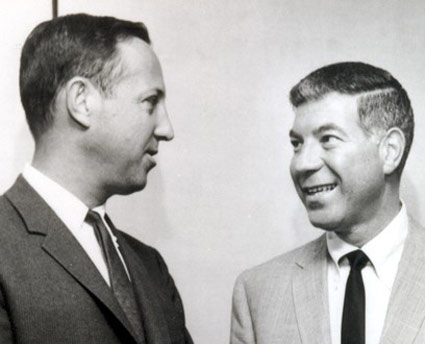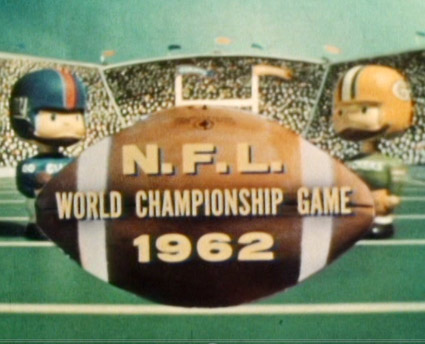Sabol's first game
You have to appreciate the risk and courage it took when Sabol, then a 46-year-old family man, walked away from a comfortable living as a coat salesman to form Blair Productions in 1962. He then when out on a limb and doubled the bid that the National Football League had accepted in 1961 to film the 1962 NFL Championship Game. The $3,000 offer certainly got the attention of NFL Commissioner Pete Rozelle, but that did not mean Sabol and his production company would instantly get the job. Rozelle decided to call him into the League's office to size him up to see if he was legit.
 Sabol did not disappoint as he wowed the commissioner with his thoughts and plans of how a football game should be portrayed. He promised to double to eight the number of cameras used on the field. He also stated how he planned to use various forms of slow motion photography. And last but not least, he vowed to use color film which at the time was somewhat of a novelty and was certainly more expensive than regular black and white film. Two days later Sabol got a telegram that stated "Congratulations…"
Sabol did not disappoint as he wowed the commissioner with his thoughts and plans of how a football game should be portrayed. He promised to double to eight the number of cameras used on the field. He also stated how he planned to use various forms of slow motion photography. And last but not least, he vowed to use color film which at the time was somewhat of a novelty and was certainly more expensive than regular black and white film. Two days later Sabol got a telegram that stated "Congratulations…"As an old adage states, "be careful what you wish for, it might come true." This was exactly the case for Sabol. He was granted the right to film the 1962 Championship Game in November which gave him just over a month to prepare a camera crew and team to handle sound, editing and production for the big game on Dec. 30. The championship match-up between the Green Bay Packers and the New York Giants came quickly but Sabol and his team were ready. He even had his crew film both teams as they practiced during the week for the title tilt, something that hadn't been thought of before.
Sabol had dotted every "I" and crossed every "T", he and his crew were ready. Mother Nature, however, was not a part of Sabol's production staff. They were greeted by frigid conditions at Yankee Stadium. The game-time temperature was 15 degrees with 30 mile per hour winds which created a wind chill factor of zero. As such, everything froze – the fans, the players, the cameras, the cameramen and the film which eventually broke because of the icy temperature. Sabol desperately tried to keep his cameramen and film from freezing by building fires in the stadium's dugout. After the game, a nauseous Sabol felt as if he had a ball of twine in his stomach when he looked at the seemingly useless film from the day's work heaped into a pile by the exhausted cameramen.
For weeks he painstakingly worked to salvage, sort and repair the film. He finally edited the footage down to a working product which portrayed a theme that could easily translate with any viewer whether they were a football fan or not – David vs. Goliath; the small-town city of Green Bay vs. the mighty Big Apple of New York City. He used filmmaker's tactics to dramatize the story and convey a sense of suspense, pain and agony as both teams battled the weather and each other to achieve the game's ultimate prize. Sabol then pulled off a small coup when he reeled in noted television broadcaster Chris Schenkel to provide the voice over narrative for the production. The final piece of the puzzle would soon become an NFL Films trademark for years to come, the music layover.
The final version of what Sabol had poured his blood, sweat, tears and money into finally premiered at Toots Shor's bar and restaurant in New York City to an audience of League officials and media members. Titled "Pro Football's Longest Day" the film was a refreshing change from previous years' highlights which more resembled lackluster coaching films. The "Pro Football's Longest Day" received rave reviews with the most important critic, Rozelle, proclaiming it to be "the best football film I've ever seen."
That was good enough for Sabol. The success launched his second career as a filmmaker as he and NFL Films would go on to develop and transform the manner in which sports are presented on film and television. Almost 50 years later, NFL Films' most significant project may be when it travels to Canton to capture Ed Sabol's enshrinement into the Pro Football Hall of Fame.

Blog: No doubt about my No. 1
As we get closer to the Enshrinement of the Class of 2011, For Pete's Sake has been counting down his top 5 enshrinement moments. Here is his No. 1.
10 years after
The Class of 2001 was the last class to be enshrined on the front steps of the Hall. This year, they return and will be on stage in Fawcett Stadium to celebrate their 10th anniversary of that special occasion.

